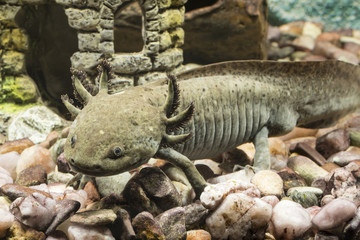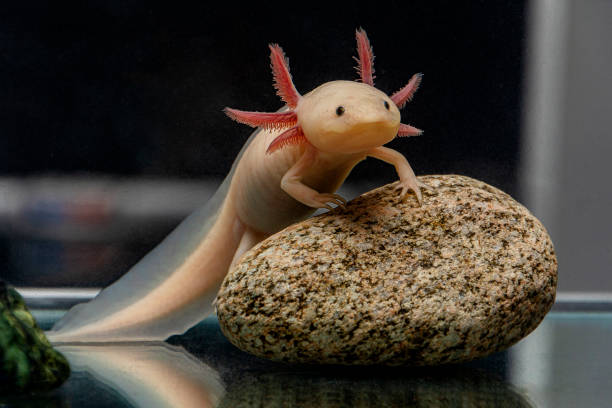The Enigmatic Axolotl: Nature’s Eternal Youth
The axolotl, often admired for its whimsical appearance and regenerative superpowers, has captured global attention as both a scientific marvel and a cultural icon. From the shelves of toy stores with the beloved axolotl squishmallow, to the virtual biomes of Minecraft axolotl spawns, and even in specialty shops listing axolotl for sale, this amphibian’s appeal is unmistakable. Whether you’re captivated by a cute axolotl swimming gracefully in an aquarium or considering caring for an axolotl as a unique pet, understanding its biology, habitat, and needs is essential. This comprehensive guide delves into the world of the axolotl—from its physical traits and axolotl diet, to its surprising behaviors, fascinating axolotl facts, and how to build the perfect axolotl tank.
Table of Contents
Scientific Classification
- Kingdom: Animalia
- Phylum: Chordata
- Class: Amphibia
- Order: Urodela
- Family: Ambystomatidae
- Genus: Ambystoma
- Species: Ambystoma mexicanum
Description / Physical Description
The axolotl (Ambystoma mexicanum), often mistaken for a fish, is a neotenic amphibian celebrated for its wide smile, fringed external gills, and lidless eyes. Unlike most amphibians, it retains its larval features throughout its life. Adult axolotls can range from 6 to 18 inches in length, although most grow to around 9 inches.
Their smooth skin is soft to the touch, sometimes appearing almost gelatinous. Axolotl colors are incredibly diverse due to selective breeding in captivity. Beyond the iconic pink axolotl, also known as leucistic, they come in melanoid (black), wild-type (mottled brown/green), golden albino, and even gfp axolotls that glow under UV light.
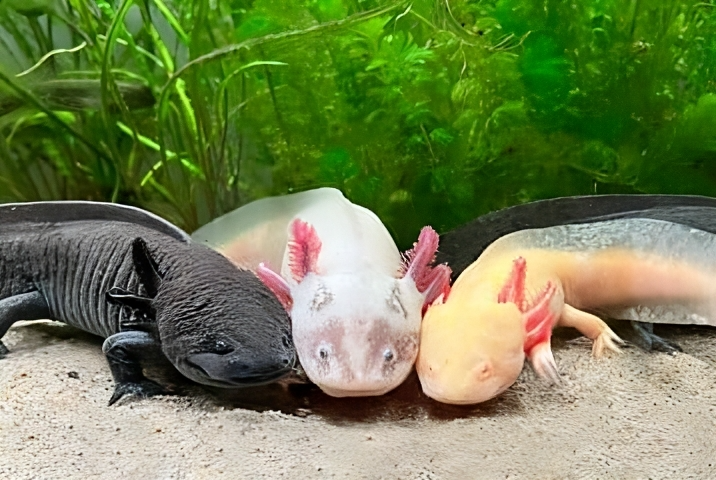
Range & Distribution
In the wild, axolotls are exclusively native to Mexico, particularly within the ancient lake system of Lake Xochimilco and Lake Chalco in the Valley of Mexico. Sadly, urbanization and water pollution have nearly eradicated their natural habitat, making wild populations critically endangered.
Habitat
Axolotls thrive in cool, freshwater environments rich in aquatic vegetation and sheltered spots for hiding. These amphibians prefer still or slow-moving waters. In captivity, their axolotl tank must emulate this environment, with clean, dechlorinated water, gentle filtration, and temperatures between 60°F to 68°F (16°C to 20°C).
A well-maintained axolotl tank includes:
- A substrate of fine sand (avoid gravel to prevent impaction)
- Live plants or soft artificial decor
- Hiding spots like ceramic caves or driftwood
- Adequate tank size (minimum 20 gallons for a single adult)
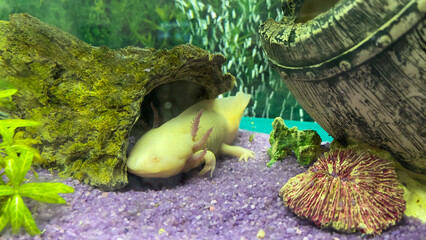
Diet
The axolotl diet is primarily carnivorous. In the wild, they feed on:
- Worms
- Small fish
- Crustaceans
- Insects
- Mollusks
Captive axolotls thrive on:
- Bloodworms
- Brine shrimp (for baby axolotls)
- Earthworms
- Axolotl pellets (nutritionally balanced)
Feeding should occur 2–3 times per week for adults and daily for baby axolotls, ensuring uneaten food is removed to maintain water quality.
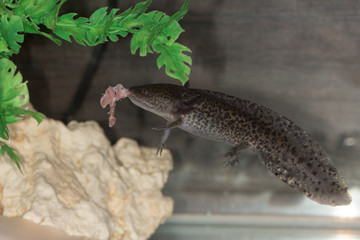
Behaviour / Lifestyle
Axolotls are solitary and nocturnal, often resting motionlessly during daylight hours and becoming active at dusk. They are ambush predators, using a quick suction mechanism to consume prey. Unlike other amphibians, they don’t croak, hop, or climb. Their lifestyle is defined by a peaceful disposition, making them excellent low-interaction pets when handled minimally.
Lifespan
With optimal axolotl care, they can live 10 to 15 years, and in rare cases, even longer. Factors impacting axolotl life expectancy include:
- Water quality
- Diet
- Temperature regulation
- Genetic health (especially in captive-bred lines)
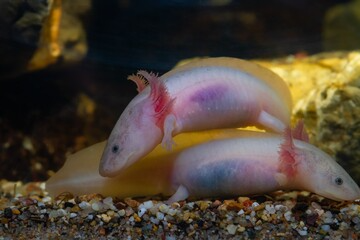
Adaptations
The axolotl’s most fascinating adaptation is neoteny—retaining larval traits like gills and an aquatic lifestyle throughout life. This trait provides several advantages:
- No need for terrestrial transition
- Enhanced regenerative abilities
- Highly sensitive lateral line system for detecting vibrations
Axolotls also exhibit limb regeneration, capable of regrowing entire limbs, spinal tissue, parts of the heart, and even brain matter—a scientific marvel attracting ongoing regenerative medicine research.
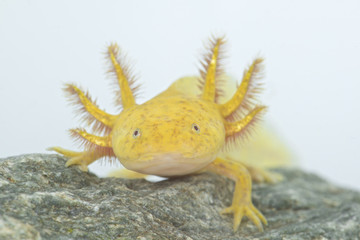
Mating & Reproduction / Reproduction & Lifecycle
Axolotls reach sexual maturity by 6 to 12 months but remain in their juvenile form. Courtship begins with a dance-like interaction where the male deposits a spermatophore, which the female picks up via her cloaca.
Key reproductive facts:
- Breeding season: Generally in late winter or early spring
- Eggs per clutch: 100 to 1,000
- Hatching time: 10–14 days
- Larvae care: Best raised separately to prevent cannibalism
Axolotl care for eggs and juveniles requires precision—stable temperature, high oxygen, and ample food like baby brine shrimp or microworms.

Predators
In the wild, natural predators include:
- Large fish (e.g., tilapia and carp)
- Birds (e.g., herons)
- Humans (as part of traditional Mexican cuisine)
In captivity, stress and disease pose more significant threats. Cohabitation with other fish or aggressive axolotls can lead to injury or limb loss—although they regenerate, prevention is better.
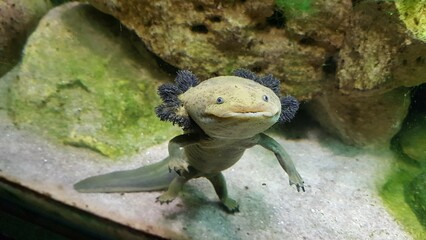
Conservation Status
The axolotl is listed as Critically Endangered on the IUCN Red List. With fewer than 1,200 individuals estimated in the wild, their survival is jeopardized by:
- Habitat destruction
- Invasive species
- Pollution
- Water drainage
Conservation efforts include:
- Captive breeding programs
- Habitat restoration in Lake Xochimilco
- Education and ecotourism in local communities
Interesting Facts
- Axolotl squishmallow toys have surged in popularity, reflecting cultural adoration.
- The minecraft axolotl introduced in Minecraft’s Caves & Cliffs update boosted global interest in these amphibians, especially among children and gamers.
- Axolotls never undergo metamorphosis unless hormonally induced.
- Unlike frogs or salamanders, they don’t lose their gills or grow lungs.
- They can recognize their owners and react to feeding routines.
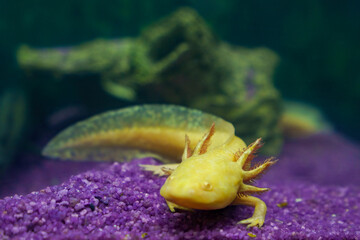
As Pets
The rise of the axolotl pet is no surprise. With their calm nature and surreal appearance, they’ve become a staple in exotic pet collections. However, caring for an axolotl requires knowledge and dedication.
Essential considerations:
- Only purchase from reputable axolotl for sale breeders
- Avoid overcrowding in tanks
- Handle only when necessary (their skin is delicate and permeable)
- Use a secure lid (they can jump during feeding or when startled)
With proper axolotl care, owners are rewarded with a charming and interactive companion.
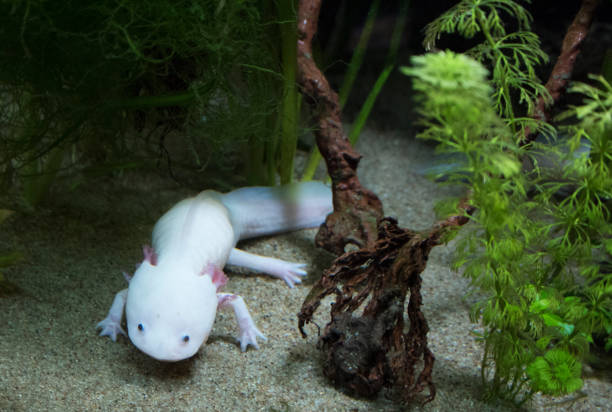
Classification of Species
The axolotl belongs to the genus Ambystoma, which includes over 30 mole salamander species. Unlike others in the group, the axolotl almost never undergoes complete metamorphosis, maintaining its larval form for life—a unique trait among Ambystomatidae.
Subspecies
Currently, there are no recognized subspecies of Ambystoma mexicanum. However, selective breeding in captivity has led to numerous morphs based on color and genetic traits:
- Leucistic (Pink Axolotl): Pale with red gills and black eyes
- Wild-type: Mottled brown/green with golden flecks
- Albino: White or gold with red gills and no pigmentation
- Melanoid: Dark, nearly black skin with no iridophores
- GFP (Green Fluorescent Protein): Glow green under UV light
These morphs are often marketed alongside plushies like cute axolotl squishmallow or inspired in virtual form by minecraft axolotl characters, further fueling their appeal.
Axolotls remain a biological marvel—both as a critically endangered wild species and a globally adored exotic pet. Their unique physiology, combined with the cultural renaissance through games and toys, ensures their place in both science and pop culture.
